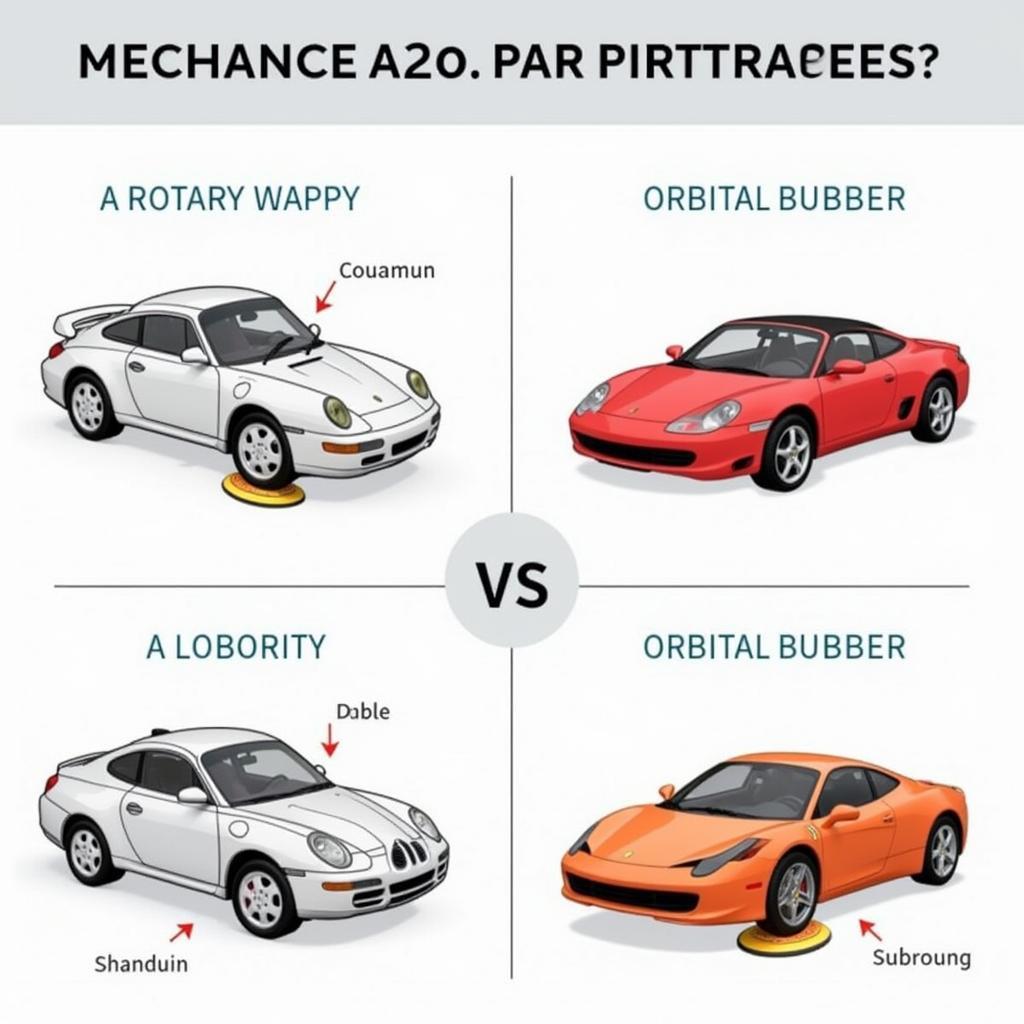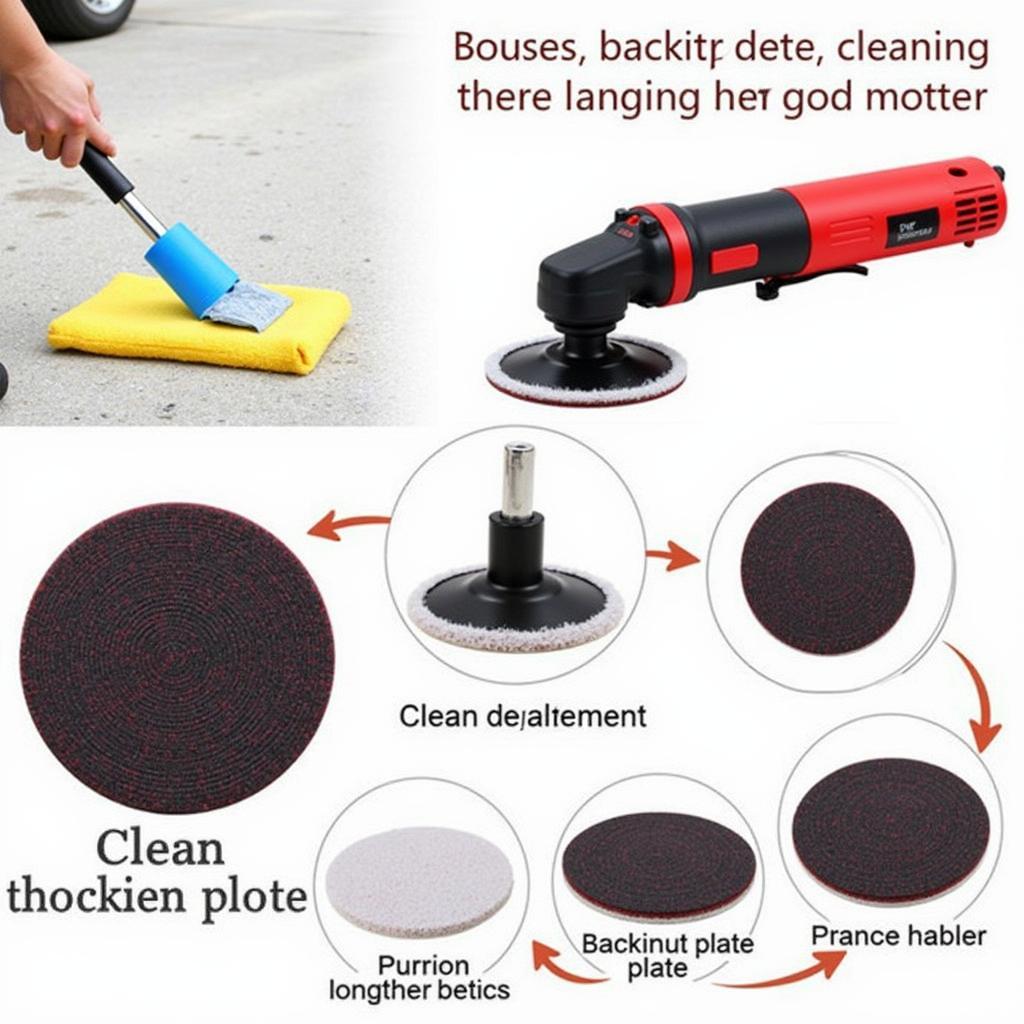A Car Detail Buffer is your key to achieving a showroom-worthy shine. Whether you’re a professional detailer or a weekend warrior, understanding the nuances of these powerful tools can transform your detailing game. From choosing the right buffer to mastering various techniques, this guide will equip you with everything you need to know about car detail buffers.
Choosing the right car detail buffer can be daunting, especially with the sheer number of options available. Let’s break down the types, features, and factors to consider when making your purchase. Understanding the differences between rotary and orbital buffers is crucial. Rotary buffers offer immense power for correcting severe paint imperfections but require a skilled hand to avoid damaging the clear coat. Orbital buffers, on the other hand, are more forgiving for beginners, mimicking hand polishing motions while still delivering impressive results. Consider the size and weight of the buffer, especially if you’ll be detailing larger vehicles or working for extended periods. A comfortable grip and variable speed control are also essential for precise and controlled polishing. For more information on selecting the perfect buffer for your needs, check out our guide on the best car detail buffer.
Types of Car Detail Buffers
There are several types of car detail buffers, each with its own strengths and weaknesses.
Rotary Buffers
Rotary buffers are the workhorses of the detailing world, offering unmatched cutting power for removing deep scratches and swirl marks. However, their high speed and direct-drive system require experience and careful technique to avoid damaging the paint.
Orbital Buffers
Orbital buffers, also known as dual-action or random orbital buffers, are a safer and more user-friendly option. Their oscillating and rotating motion minimizes the risk of burning or swirling the paint, making them ideal for beginners. If you’re unsure about which size orbital buffer to choose, our guide on car detail 5 or 6 inch orbital buffer can help.
Dual-Action Polishers
Dual-action polishers combine the cutting power of rotary buffers with the safety of orbital buffers. They offer a balance between aggressive correction and user-friendliness.
 Rotary vs. Orbital Car Detail Buffer Comparison
Rotary vs. Orbital Car Detail Buffer Comparison
Choosing the Right Pad and Polish
Pairing the correct pad and polish with your car detail buffer is crucial for achieving optimal results. Different pads offer varying levels of aggressiveness, from heavy-cutting wool pads to softer foam pads for finishing. Similarly, polishes come in a range of cutting strengths, from compounds designed to remove deep scratches to finer polishes for enhancing gloss and shine. Experimenting with different pad and polish combinations is essential to finding the perfect match for your car’s paint condition. Choosing the right car detailing gear is essential for success.
Techniques for Using a Car Detail Buffer
Mastering the proper techniques for using a car detail buffer is essential to achieving a flawless finish and avoiding paint damage. Always start with a clean and dry surface, free of any loose dirt or debris. Apply a small amount of polish to the pad and spread it evenly over a small section of the car. Work in overlapping passes, applying gentle pressure and keeping the buffer moving to avoid heat buildup. Regularly inspect the pad for excess polish or debris and clean it as needed. For more demanding detailing tasks, you might consider whether do i need generator for car detailing.
Maintaining Your Car Detail Buffer
Proper maintenance will extend the life of your car detail buffer and ensure optimal performance. Regularly clean the buffer’s backing plate and pads to remove any polish residue or debris. Inspect the power cord for any damage and replace it if necessary. Store the buffer in a clean and dry environment to prevent corrosion or damage to the motor. A well-maintained buffer will provide years of reliable service.
“A clean buffer is a happy buffer,” says renowned detailing expert, Michael Bloomfield. “Regular maintenance is essential for preserving the performance and longevity of your investment.”
 Maintaining Your Car Detail Buffer
Maintaining Your Car Detail Buffer
Conclusion
A car detail buffer is an invaluable tool for achieving a professional-level finish. By understanding the different types of buffers, choosing the right pads and polishes, and mastering the proper techniques, you can transform your car’s appearance and protect its paint. With practice and patience, you’ll be able to achieve stunning results and enjoy the satisfaction of a perfectly detailed car. Investing in a quality car detail buffer is an investment in the long-term beauty and value of your vehicle.
FAQ
- What is the best type of car detail buffer for beginners?
- How often should I clean my car detail buffer pads?
- What is the difference between a cutting pad and a polishing pad?
- Can I use a car detail buffer on all types of paint?
- What is the best way to remove swirl marks from my car’s paint?
- How do I prevent burning the paint when using a car detail buffer?
- What type of polish should I use with a car detail buffer?
Need assistance with choosing the right car detail buffer or other car detailing queries? Contact us via WhatsApp: +1(641)206-8880 or Email: [email protected]. Our 24/7 customer service team is always ready to help. We also have more information about high speed buffer for car detailing.

Leave a Reply